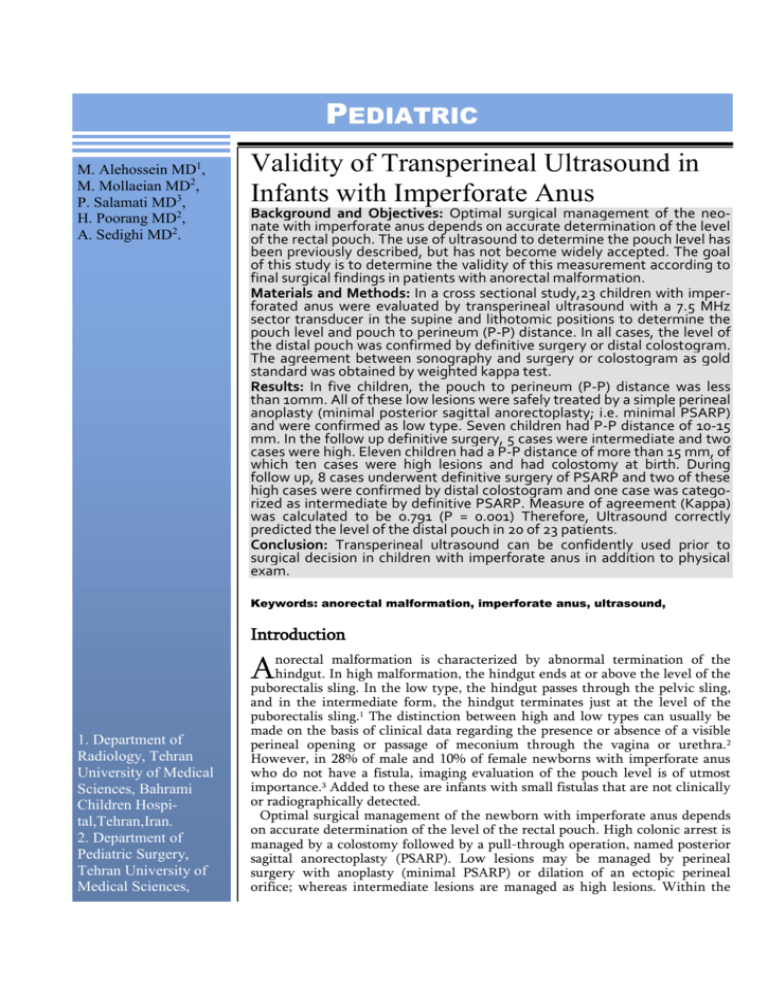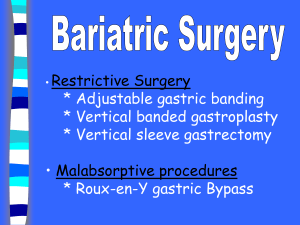IJR
advertisement

PEDIATRIC M. Alehossein MD1, M. Mollaeian MD2, P. Salamati MD3, H. Poorang MD2, A. Sedighi MD2. Validity of Transperineal Ultrasound in Infants with Imperforate Anus Background and Objectives: Optimal surgical management of the neonate with imperforate anus depends on accurate determination of the level of the rectal pouch. The use of ultrasound to determine the pouch level has been previously described, but has not become widely accepted. The goal of this study is to determine the validity of this measurement according to final surgical findings in patients with anorectal malformation. Materials and Methods: In a cross sectional study,23 children with imperforated anus were evaluated by transperineal ultrasound with a 7.5 MHz sector transducer in the supine and lithotomic positions to determine the pouch level and pouch to perineum (P-P) distance. In all cases, the level of the distal pouch was confirmed by definitive surgery or distal colostogram. The agreement between sonography and surgery or colostogram as gold standard was obtained by weighted kappa test. Results: In five children, the pouch to perineum (P-P) distance was less than 10mm. All of these low lesions were safely treated by a simple perineal anoplasty (minimal posterior sagittal anorectoplasty; i.e. minimal PSARP) and were confirmed as low type. Seven children had P-P distance of 10-15 mm. In the follow up definitive surgery, 5 cases were intermediate and two cases were high. Eleven children had a P-P distance of more than 15 mm, of which ten cases were high lesions and had colostomy at birth. During follow up, 8 cases underwent definitive surgery of PSARP and two of these high cases were confirmed by distal colostogram and one case was categorized as intermediate by definitive PSARP. Measure of agreement (Kappa) was calculated to be 0.791 (P = 0.001) Therefore, Ultrasound correctly predicted the level of the distal pouch in 20 of 23 patients. Conclusion: Transperineal ultrasound can be confidently used prior to surgical decision in children with imperforate anus in addition to physical exam. Keywords: anorectal malformation, imperforate anus, ultrasound, Introduction norectal malformation is characterized by abnormal termination of the hindgut. In high malformation, the hindgut ends at or above the level of the A puborectalis sling. In the low type, the hindgut passes through the pelvic sling, 1. Department of Radiology, Tehran University of Medical Sciences, Bahrami Children Hospital,Tehran,Iran. 2. Department of Pediatric Surgery, Tehran University of Medical Sciences, Bahrami Children Hospital, Tehran,Iran. 3. Department of Community Medicine, Tehran University of Medical Sciences, and in the intermediate form, the hindgut terminates just at the level of the puborectalis sling.1 The distinction between high and low types can usually be made on the basis of clinical data regarding the presence or absence of a visible perineal opening or passage of meconium through the vagina or urethra.2 However, in 28% of male and 10% of female newborns with imperforate anus who do not have a fistula, imaging evaluation of the pouch level is of utmost importance.3 Added to these are infants with small fistulas that are not clinically or radiographically detected. Optimal surgical management of the newborn with imperforate anus depends on accurate determination of the level of the rectal pouch. High colonic arrest is managed by a colostomy followed by a pull-through operation, named posterior sagittal anorectoplasty (PSARP). Low lesions may be managed by perineal surgery with anoplasty (minimal PSARP) or dilation of an ectopic perineal orifice; whereas intermediate lesions are managed as high lesions. Within the Validity of Transperineal Ultrasound in Infants with Imperforate Anus high group, defects such fistula are both considered high, yet the former can be repaired via posterior as rectoprostatic fistula sagittal entry only, and the latter requires an additional laparotomy. But in fact, and rectobladder neck anorectal malformation represents such a wide colostogram. The agreement between sonography spectrum of defects; that, the terms low, intermediate and surgery or colostogram as gold standard was obtained by weighted kappa test. and high are arbitrary and not useful in therapeutic or prognostic terms.4 Many reports are available in the literature about the accuracy of ultrasound (US) to determine the location of the rectal pouch in patients with imperforate anus. However, this method has not become widely accepted. 5 To our knowledge, US findings have not been compared with surgical findings. The main purpose of our study was to assess the validity of transperineal ultrasonic measurement in comparison with surgical findings as a gold standard in patients with imperforate anus. Materials and Methods This cross sectional study was done in a referral pediatric surgery department within two years. Twenty-three children with imperforate anus were evaluated with ultrasound to locate the level of the distal pouch. A pediatric radiologist performed the study. Scanning was performed with a 7.5 MHz sector transducer (Siemens SL2, Germany). The infants were placed in the supine and lithotomic positions. The probe was placed over the anal dimple of the perineum without compression. Midline sagittal scanning was performed to measure the distance from the end of the distal rectal pouch to the perineum (P-P) (Figures 1 and 2).We considered P-P distance less than 10mm as low type,10-15mm as intermediate type and more than 20mm as high type malformation. Care was taken to neither press the probe nor measure while the child was crying. Each examination required 15-20 minutes and was performed without sedation. Some cases were evaluated while the distal pouch had been filled with saline via the stoma. Additional findings such as the status of kidneys, sacrum, presence or absence of a fistula (Fig 3) and the urogenital tract configuration were also documented. In all cases, the level of the distal pouch was confirmed by definitive surgery or distal colostogram. All patients were managed by colostomy, and 19 cases were followed by a final anorectoplasty. The type of lesion was determined on the basis of the international classification, which is based on the relationship of the level of the distal rectal pouch to the puborectalis portion of the levator ani muscles. The type of operation was also noted. In 4 cases with only a colostomy at the time of study, the pouch level was determined based on the clinical data and a distal 2 Figure1: Electronic calipers (+) on this sagittal section with transperineal approach show the pouch to be only a few millimeters from the perineal skin (anal dimple) (P-P < 10mm). Figure 2: A longitudinal section shows the sacrum (s), rectal pouch (R) and uterus (U) with a P-P distance of 10-15mm. Iran. J. Radiol., June 2003; M. Alehossein et al Figure 3: A longitudinal (sagittal) image obtained from the perineum shows the fistula between the rectal pouch and prostatic or bulbar urethra. Table 1: Comparison results of sonography and Gold standard Gold standard ( surgery) Test (US) High Intermediate Low Total High Intermediate Low Total 10 2 12 1 5 6 5 5 11 7 5 23 Seven children had a P-P distance of 10-15mm, of which 5 cases were confirmed as intermediate and two cases as high type(Table 1).(4 cases were managed by definitive PSARP surgery, 1 case by PSARP + LAP, and 2 cases by colostogram). Eleven children had a P-P distance of 15-35 mm (i.e. high type malformation), of whom 8 cases were reported as being high, with final surgery of PSARP or PSARP + LAP. One case was intermediate. Two of these children had a P-P distance of 15-20 mm. Both cases had colostomy and distal colostogram which showed rectourethral and rectovaginal fistulas, therefore reported as high lesions (Fig 4). (Table 1) Thus ultrasound correctly determined the level of the distal pouch in 20 of 23 cases (19 cases approved by definitive surgery results and 4 cases with clinically recognized fistula or distal colostogram) Measure of agreement (Kappa) was calculated to be 0.791 (P = 0.001). Rectourethrobulbar fistula was seen in 4 cases and was the most common fistula in the boys and rectovestibular fistula was found in 3 girls. Three rectovaginal fistulas were seen. Rectovesical neck fistula was noted in 2 cases, both of which needed PSARP + LAP. However, there were 2 other cases whom had this operation and lacked a fistula. Renal agenesis was seen in 3 cases (all were right-sided and confirmed by DMSA scan or surgery). One case had a multicystic dysplastic kidney on the left with a rightsided ectopic kidney. Discussion Figure 4: A high lesion according to the P-P distance (15-20 mm). The rectal pouch (REC) and anal dimple (ANUS) in transperineal approach with mid sagittal measurement. Results Of all 23 patients, there were 15 male and 8 female. (eleven neonates and twelve aged 2 to 15 months old).Five children had a P-P distance of < 10mm (low type). All the malformations were corrected surgically, with minimal PSARP in 4 cases and resection of anal hamartoma in the one case. All the 5 cases were reported as low type by the surgeons. (Table 1) Iran. J. Radiol., June 2004; The radiographic modalities used in imaging the imperforate anus include invertogram and prone cross-table lateral view.7,8 However, if impacted meconium prevents gas from reaching the most distal extent of the pouch, it may appear higher than it actually is. Likewise, it may appear erroneously high if the pouch is decompressed through a fistula or if the levator muscles are contracted during the imaging. Moreover, the infant placed in an upside-down position may become hypoxic. Other modalities include ultrasound (US), computed tomography (CT) and magnetic resonance imaging (MRI). In spite of early use of ultrasound in children with imperforate anus (first described by Willital in 1971 by A-mode, Schuster by primary B-mode, Oppenheimer by real time US and Donaldson in 1989),9 it has not become widely accepted, especially in Iran. An advantage of US is the ability to image the end of the pouch, regardless of whether it is impacted with meconium or not. Complex genitourinary anomalies that may displace the pouch can also be quickly recognized.9 US has no radiation risk and is 3 Validity of Transperineal Ultrasound in Infants with Imperforate Anus not as expensive as MRI or CT scan. Using US, internal fistula can be identified as well.10 Donaldson evaluated 18 children with imperforate anus by US mostly using a suprapubic approach, and in few cases through the perineum. Ultrasound correctly predicted the level of the pouch in all 12 children who had confirmation of pouch level by surgery or distal colostogram. However, definite surgery for confirming pouch level was performed only in one case out of 7 cases with a P-P distance more than 15 mm.9 In our study all the examinations were performed by a transperineal approach. Of our 23 cases, nineteen underwent definitive surgery according to the more long-term follow up of the patients. Ultrasound correctly predicted the level of the pouch in 20 cases. Thus the validity of this test was high in our series (0.79). However, none of the other studies had previously reported a significant correlation. In an article by Tae Han stating a new infracoccygeal approach to see puborectalis muscle in 14 cases, there was no mention of intermediate cases. But he found some overlap in the measurements for high and low-type imperforate anus.11 There is some overlap between intermediate and high types in our series and between intermediate and low in Donaldson’s study. These overlaps in the intermediate type may be caused by varying degrees of pouch distention and also may be due to the infant’s age. According to the current terminology, such terms as high, intermediate and low are confusing and inaccurate.12 Since this congenital defect has a spectrum, by moving towards the simpler end of the spectrum (low), there is a better chance of having a normal sacrum, normal muscles, and a “good looking perineum”. By moving towards the more complex end however, the chances for having a very poorly developed sacrum, and therefore, poor innervations, underdeveloped muscles, and a narrow pelvis significantly increase.13 Low cases do not require a previous protective colostomy. The child may be treated during the neonatal period with minimal PSARP. Intermediate and high cases require colostomy at 4-8 weeks of age, and eventually final PSARP is performed in the prone position. However, a rectal pouch may not be found in this position (similar to a rectobladder neck fistula in males and high vaginal fistula in females). Therefore, the position of the child is changed to supine and an abdominal laparotomy (LAP) is performed in addition to the PSARP (PSARP + LAP), which adds two more hours to the operation time.13 Prior evaluation of the pouch level can decrease the surgery time as well as the complications of such an extensive dissection.13 In our series, all cases with a P-P distance of less than 10 mm had a final surgery as low lesions 4 (minimal PSARP and resection), which reconfirms the validity of this newer approach; using US instead of lateral abdominal radiography.14 Among 7 children with the intermediate sonographic range (P-P = 10-15mm), 5 cases were confirmed by definite surgery to be intermediate, but 2 cases were high. This overlap has been discussed in the previous studies as well.9,11 A setback in two cases was inaccurate estimation of the distance due to the gas within the pouch (instead of the more reliable finding of fluid within the pouch). Out of 11 cases with sonographic high type (> 15 mm), the high position was confirmed in at least 10 cases (in 8 cases with surgery and in 2 cases based on the accompanying fistula). The only case with the inaccurate estimation of the P-P distance could probably be prevented if we had not relied only on the gas within the pouch. A cut-off point of more than 15 mm likely has enough sensitivity and specificity to distinguish the high type malformation. Male to female ratio was more than 2 in our series, and there was a predominance of females in the intermediate group rather than in the high group as in other references.12 High- to- low type ratio was also prominent in our series.5-11 As noted earlier, three rectovaginal fistulas were seen. However, according to the new references, true rectovaginal fistulas are extremely rare and most of them may be a cloaca.14 The new classification of anorectal malformation based on fistulas probably cannot predict all the required surgical methods.12 Occasionally, fistulas are visible directly by US. In one case, filling the pouch during spontaneous voiding could imply fistula between the urinary tract and rectum. According to this study, this is shown that transperineal ultrasound can be confidently used in addition to physical exam prior to making the surgical decision in children with an imperforate anus. References 1. Sivit EJ, Siegel MJ. Gastrointestinal Tract. In: Siegel MJ. Pediatric Sonography 3rd ed. Philadelphia: Lippincott- Williams and Wilkins, 2002: 373- 374. 2. Seibert JJ, Golladay ES. Clinical evaluation of imperforate anus: clue to type of anal – rectal anomaly. AJR Am J Roentgenol 1979; 133: 289 292. 3. Raffensperger JG. Anorectal anomalies. In: Swensons Pediatric Surgery, 4th ed. Norwalk, CT: Appleton- Century-Crofts, 1980:539-578. 4. Hirscl RB. Anorectal disorders and imperforate anus .In: O,Neil Jr JA, Grosfeld JL, Fonkaalsrud EW, Coran AG, Caldamone AA. Principles of Pediatric Surgery .3rd ed. St Luis: Mosby, 2003:596- 602. 5. Oppenheimer DA, Carroll BA, Shochat SJ. Sonography of imperforate anus. Radiology 1983;148: 127-128. Iran. J. Radiol., June 2004; M. Alehossein et al 6. Schuster SR, Teele RL. An analysis of ultrasound scanning as a guide in determination of high or low imperforate anus. J Pediatr Surg 1979; 14: 798-800. 7. Wangesteen OH, Rice CO. Imperforate anus: A method of determining the surgical approach .Am J Surg 1930; 92: 77-81. 8. Narasimharao KL, Prasad GR, Katariya S, et al. Prone cross table view: an alternative to the invertogram in imperforate anus .AJR 1983; 140:227-229. 9. Donaldson JS, Black CT, Reynolds M, et al. Ultrasound of the distal pouch in infants with imperforate anus. J Pediatr Surg 1989; 24: 465468. Iran. J. Radiol., June 2004; 10. Kim IO, Han TI, Kim WS, et al .Transperineal ultrasonography in imperforate anus: Identification of the internal fistula .J Ultrasound Med 2000; 10: 211-216. 11. Han TI, Kim IO, Kim WS. Imperforate anus: US Determination of the type with Infracoccygeal approach. Radiology 2003; 228: 226-229. 12. Pena A. Imperforate anus and cloacal malformations. In: Ashcraft, Murphy JP, Sharp RJ , Sigalet DL. Synder CL. Pediatric surgery. 3rd ed. Philadelphia: Saunders, 2000: 473 -492. 13. Pena A. Surgical management of anorectal malformations.1990:1-70. 14. Pena A, Hong A. Anorectal Malformations. In: Mattei P. Surgical directives Pediatric surgery. Philadelphia: Lippincott Williams and Wilkins, 2003: 414 -420. 5






